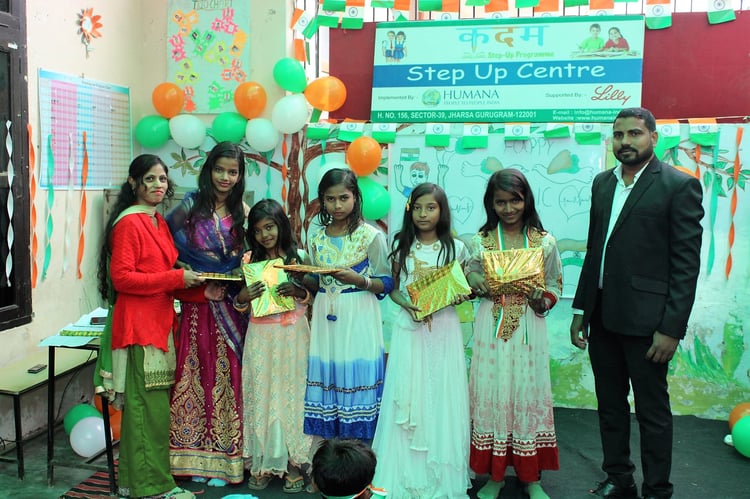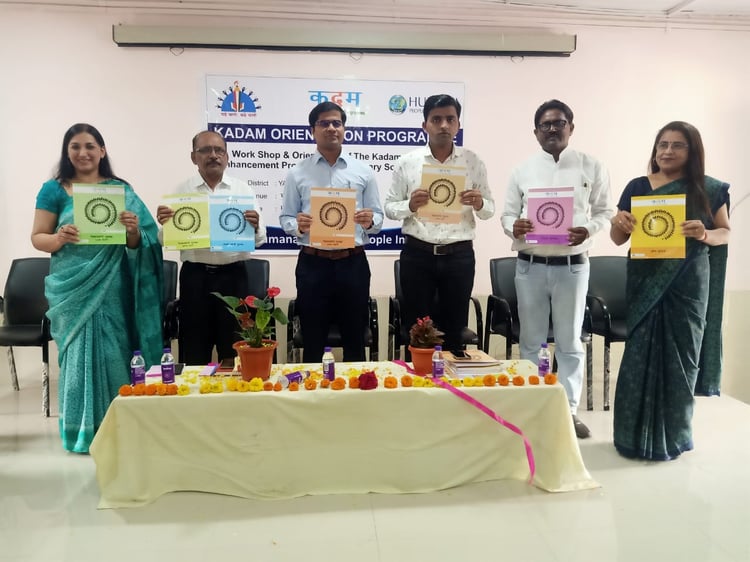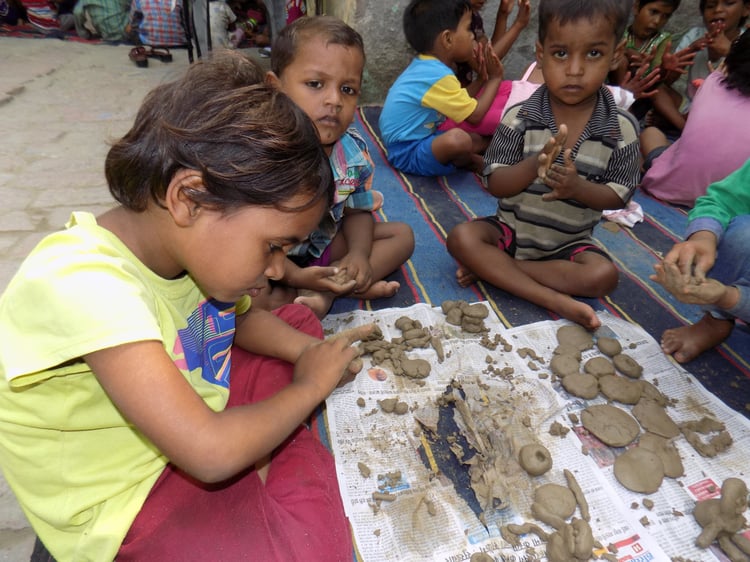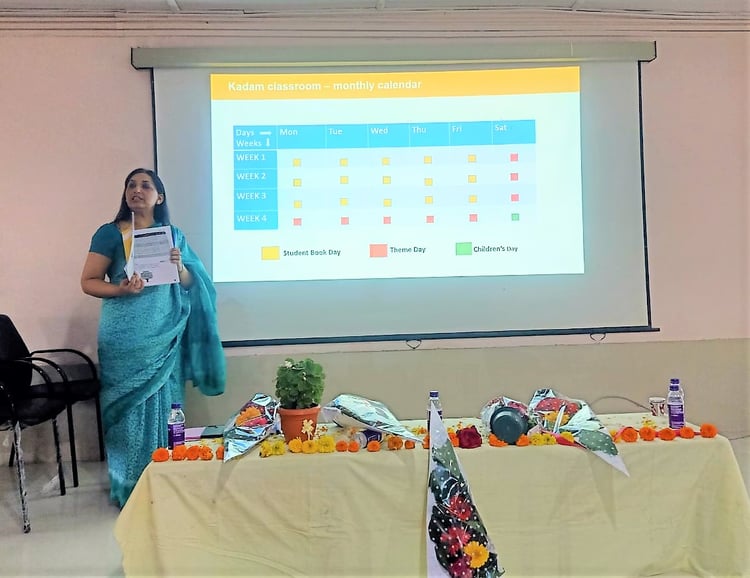Kadam Step Up Programme: In depth on pedagogy and methodology

Humana People to People India developed the Kadam Step-Up Programme with a vision of creating sustainable societies led by people as agents of change, by riding on the strengths of education as a powerful instrument of bringing people together. It uses the educational model to holistically develop disadvantaged out-of-school children at primary school level for Grades 1 - 5.
Key features of the education model makes it unique, different and relevant in responding effectively to the existing challenge of children who are being deprived their right to education due to social and economic conditions, issues children affected do not have the capacity to tackle as they are outcomes of societal inequalities. Since the inception of the Kadam Step-Up Programme, marked positive success has been observed ranging from scaling-up and rapid expansion, increased funding and recognition by national government's ministry of Education as well as international organisation as an innovative education initiative addressing children's difficulties to access education in settings facing hardships. What makes Kadam Step-Up Programme special and create conducive learning environments for accelerated learning for out-of-school children is presented below:
Holistic Development

The Kadam Step-Up Programme for out-of-school children seeks to help children at the primary school level to improve their subject skills and knowledge by focusing on mathematics, environmental science, Hindi, and English.
The program strengthens formal learning skills of students and is carried out as a package of learning that children can pursue at their own individual pace and level in the formal public education structure. Kadam Step-Up Programme differs from other programs because, along with attending to the cognitive skills of students, it also develops their social, emotional, and real-life skills. The building of life skills is done through thematic learning. The program helps in the all-round development of children through blending formal learning and skill-based experiences to engage students effectively during their course of study. This approach integrates reasoning and analysis with the application of learning to real-life situations.
Connecting with the community and sharing experiences enhances and deepens learning. The program has several events—Theme Days, Student Competitions, and Parent-Teacher Meetings — that involve students' interaction with members of the community in the school. Thus, learning beyond the book is an important element of the education model. Singing and reciting, drawing and painting, creating and building, scripting and presenting role-plays are some activities that encourage creativity and holistic learning.
Themes, is an important part of the program, as the headlines address the skill-building component of the program. The entire program is divided into 11 Themes and each Theme runs for one month. The Themes are chosen to help the students learn more about their own personality and character and explore their immediate surroundings, which include the worlds of both living beings and non-living things. The Themes also help to connect many other areas of the curriculum and thus links learning in the course. They allow learning to grow progressively by building upon a new associated vocabulary, which, in turn, helps students to read, to speak, and to write sentences linked to the idea of the Theme.
Self-paced, multi-graded learning
The Kadam Step-Up Programme is implemented in the classroom by building a multi-graded learning environment where children learn progressively from one step to the next, at their own pace. The learning level of each child varies, and so does the step from where they begin the program and the step where they end it. Therefore, the classroom becomes multi-graded.
Self-pacing or self-paced learning is an essential element of a multi-graded classroom as children are at different learning levels, they need to work their own way through the program at their own pace. The program takes into account the fact that some children learn more quickly than others, some children are regular, and some children are able to grasp concepts better. Self- paced learning by students is the answer. Children in Kadam Step-Up Programme take their own time to complete their tasks, without having to deal with the burden of a deadline or other time restriction, thus freeing them to explore various concepts and areas of learning.
To pursue learning effectively in a self-paced, multi-graded classroom situation, TRIOs of children are formed (that is, three children form a group). Teamwork and peer learning play a very important role in the personal development of students, as they make children not only socially viable but also confident enough to take on challenges in life with each other's support. Children organised in TRIOs may work on their individual tasks or on the group project, allowing each child to self-pace their learning and yet work together as a team. Working in TRIOs encourages cooperation, coordination, and a sense of responsibility in students.
Child-driven learning
Another important feature of the Kadam Step-Up Programme is facilitating children by applying previous learning to new situations, learning from their own experiences, being responsible for completing tasks on their own, and self-assessing themselves in the process. Many programs are child-oriented, and it is the child-driven feature that instils a sense of responsibility and ownership in them so they can self-direct their learning.
In Kadam Step-Up Programme, children steer their own learning. The sequence is simple. Before attempting the exercises in the Student Books, the children go through the learning competencies as given in the Meri Checklist to determine what they are going to do; then they attempt the exercises for the related competency; once all the corresponding exercises are finished, the students go back to Meri Checklist and fill in the date on which they completed all the exercises for the competency, thereby self-assessing themselves. Their entry in Meri Checklist is later supported by the teacher with a signature. Kadam Step-Up Programme allows children to drive their own learning through tracking own progress using charts which displays the status and progress of the children in the program.
Creating a fluid learning environment

The Kadam Step-Up Programme inspires and motivates children in many ways to develop teamwork, and to find solutions to problems on their own or with the help of their peers. Apart from learning, it helps immensely in facilitating the personal growth of children. The learning environment in the Kadam Step-Up Programme centre is relevant to, and reflective of, the children's socio-cultural background and is also based on their past learning experiences. Various child-initiated teaching approaches are employed to ensure the efficacy and sustenance of learning. Learning is not limited to the amount of time the learners spend in the program alone. Fluid learning flows out of the classroom into multiple social contexts that provide authentic learning opportunities.
The teacher as a facilitator and co-constructor of learning

The role of a teacher in the Kadam Step-Up program is markedly different from that of a traditional classroom teacher. In the Kadam Step-Up Programme, the teacher is more like a facilitator who guides and helps the children by clearing their doubts rather than imposing his or her ideas on them. The teacher creates opportunities for the children to explore, discover, and experience the world around them on their own. The children are not merely taught through the €œchalk and talk€ method; instead, they learn by doing. The entire learning process is child- oriented and child-driven and is aimed at achieving specific learning outcomes.
The Kadam Step-Up Programme teacher is also the co- constructor of activities, who creates a conducive learning environment and provides engaging activities to help the children gain formal learning and social skills. The teacher supports the children from the beginning of the program till they are mainstreamed and retained in the formal system of education.
Retention in the formal system of education
Another special component of Kadam Step-Up Programme is the post-accelerated foundational learning retention in formal schools, tracking, and follow-up of students in the formal public schools. Once the child has been integrated at an age- appropriate learning level, the Kadam Step-Up Programme teachers and resource persons track the child in the school on a monthly basis for the next six months. A proper tracking system and a reporting mechanism are essential components of My Progress Book in which a record is kept of the child's progress.
It has been found that when the child is integrated at an appropriate age level, the chances of the child dropping out are reduced, as the child is able to associate new learning with the foundational learning from the bridge course. Hence, at Kadam, a great deal of attention is given to providing a robust system of learning activities that remain with the child for a long time, building a rock-solid foundation for the concepts on which further lessons are based.
